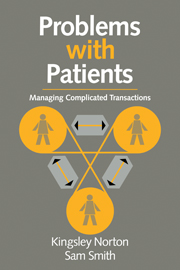Book contents
- Frontmatter
- Contents
- Foreword by Professor Paul Freeling, O.B.E.
- Preface
- Acknowledgments
- 1 Doctor–patient interaction
- 2 The clinical transaction
- 3 Interpersonal influences
- 4 The influence of past relationships
- 5 Contextual influences
- 6 Managing complicated clinical transactions
- 7 Interventions in complicated clinical transactions
- 8 Implications for the clinical setting
- 9 Implications for training
- Appendix I Clinical phenomena related to ‘problem patients’
- Appendix II Personality disorder
- References
- Index
5 - Contextual influences
Published online by Cambridge University Press: 19 March 2010
- Frontmatter
- Contents
- Foreword by Professor Paul Freeling, O.B.E.
- Preface
- Acknowledgments
- 1 Doctor–patient interaction
- 2 The clinical transaction
- 3 Interpersonal influences
- 4 The influence of past relationships
- 5 Contextual influences
- 6 Managing complicated clinical transactions
- 7 Interventions in complicated clinical transactions
- 8 Implications for the clinical setting
- 9 Implications for training
- Appendix I Clinical phenomena related to ‘problem patients’
- Appendix II Personality disorder
- References
- Index
Summary
Introduction
Miss Lake attends complaining of a third episode of sore throat within the period of a year. Before making the appointment she had had an argument with her mother, a chronic invalid, who told her there was nothing wrong with her. Under other circumstances Miss Lake might have struggled on, but fed up with her mother's demands and stung by her lack of sympathy, she presents herself to the doctor in pursuit of the barely conscious goals of getting the sympathy she feels she deserves and at the same time arming herself for revenge on her mother with the proof that she is genuinely ill.
Clinical transactions between patient and doctor do not take place in a vacuum. Each participant is influenced in sometimes subtle and, at other times, penetrating ways by factors that have their origins in contexts external to the transaction itself and may serve to make it complicated. Of these contexts, multiple and overlapping, within which doctor and patient operate, some will be shared and others not. Community, race, gender, social class, position in family, for example, all form contexts that may bring influences to bear on patient and doctor in terms of the dynamics of their interaction. At the public level these might include the shared values and expectations conferred by the social roles of doctor and patient. But those expectations and values will themselves be modified in quality and degree by the personal contexts of each participant, by any idiosyncratic, eccentric or unconventional aspects of doctor and patient as individuals.
- Type
- Chapter
- Information
- Problems with PatientsManaging Complicated Transactions, pp. 67 - 83Publisher: Cambridge University PressPrint publication year: 1994



